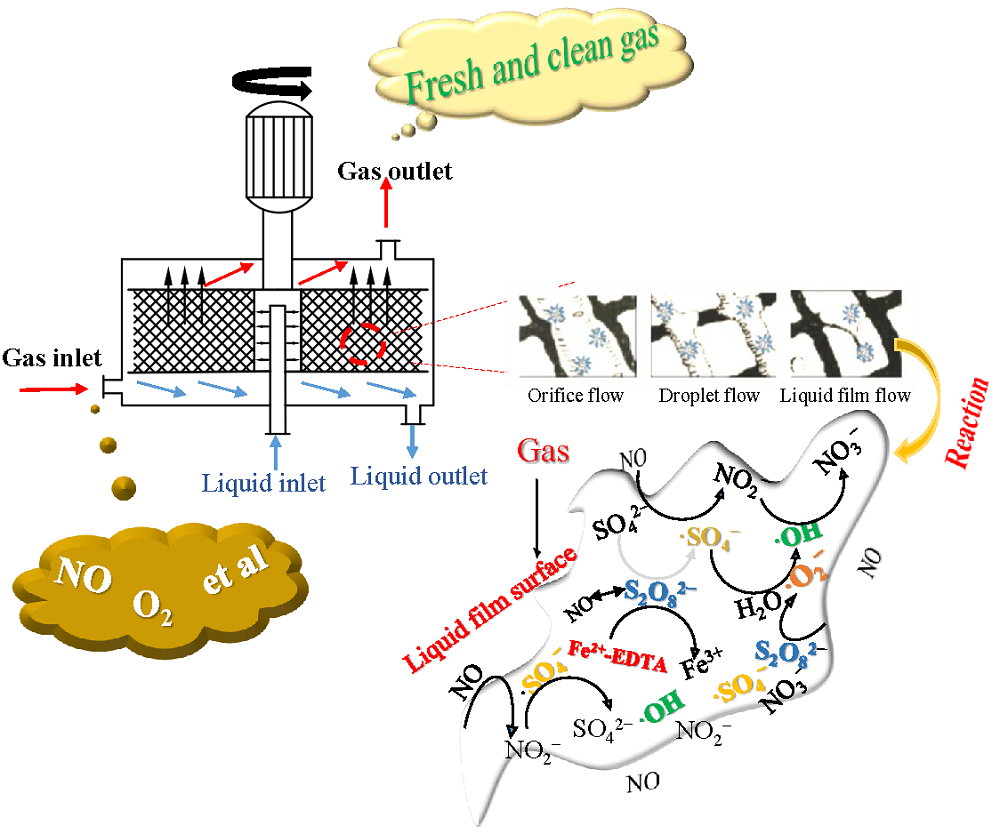Oxidation absorption technologies are to oxidize insoluble NO into higher NO
x, which is the most widely studied denitrification process. Therefore, screening and developing the cost-effective oxidants to improve the solubility of NO in water is the key to oxidative denitrification process. Hence, the use of NaClO [
13], NaClO
2 [
14], KMnO
4 [
15], H
2O
2 [
16], peroxymonosulfate (PMS) [
17] and persulfate (PS) [
18], etc. for this purpose are the current research hotspots. In contrast, PS is a cost-effective and environmentally friendly oxidant with standard oxidation−reduction potential to be
E0 = +2.01 V, which shows its strong oxidizing properties. It is also more stable than H
2O
2 and is easy to store and transport. Some studies have shown that the •SO
4– and •OH produced by PS activation bears high redox potential and strong oxidizing ability, hence high removal efficiency for the pollutants can be achieved [
19,
20]. At the same time, heat, ultraviolet radiation, ultrasound and transition metal ions can also effectively activate the •SO
4– and •OH produced by PS [
21]. The use of Fe
2+ homogeneous activation of PS in the activation of transition metals has attracted wide attention [
22,
23], because of its low price, easy activation process, high efficiency, and no requirement for additional energy. However, Fe
2+ is easy to inactivate and the large accumulation of Fe
3+ in the system will cause the decreased reaction rate [
24]. The chelating agent ethylenediaminetetraacetic acid (EDTA) is often added to form a complex with Fe
2+ to adjust and maintain the concentration of Fe
2+ to reduce unnecessary losses [
25], while promoting Fe
2+ regeneration and reducing Fe
3+ accumulation. Adewuyi et al. [
26] also showed that the removal efficiency of NO in the Fe
2+-EDTA system is much higher than that of achieved in the Fe
2+ activation system, and revealed that Fe
3+-EDTA and Fe
2+-EDTA (NO) can be converted into Fe
2+-EDTA. Meanwhile, some studies [
26–
28] also showed that the gas–liquid mass transfer resistance during the oxidation of NO had a great influence on NO removal efficiency (
ηNO) in traditional reactors such as bubbling towers. Liu et al. [
29] designed an impinging stream reactor and investigated its removal performance for NO and SO
2 using PMS with synergic activation of Cu
2+/Fe
3+ at high temperature, and found that the NO absorption rate was increased by increasing the gas phase mass transfer coefficient and interfacial area in the reactor structure. Chen and Hu [
30] had developed a multi-stage bubble reactor combined with an agitator, which increased the NO content in liquid and promote the gas–liquid mass transfer. Thus, selecting a reactor with high mass transfer efficiency to enhance gas–liquid mass transfer is the key task to improve
ηNO and reduce reactor volume during this research.













